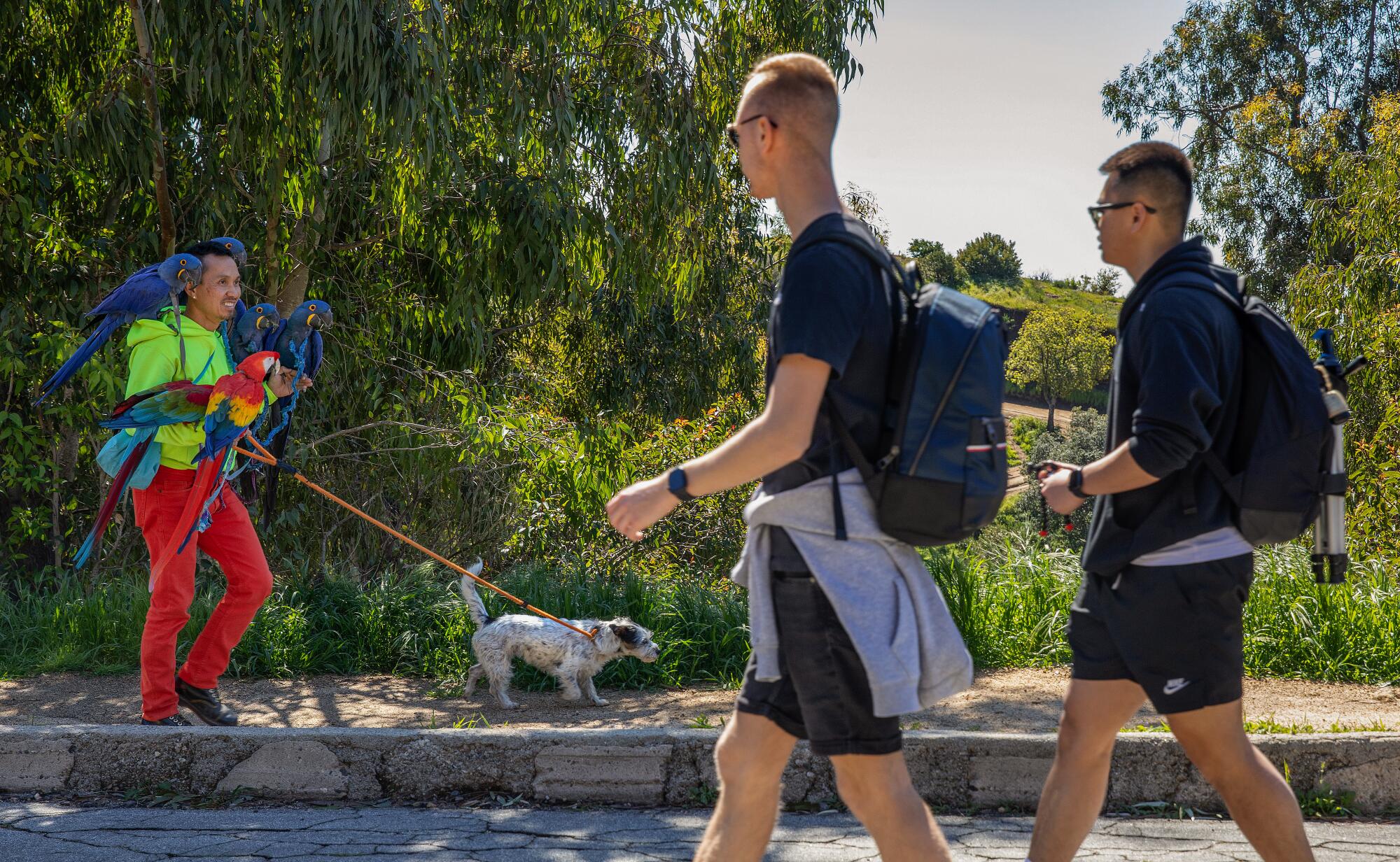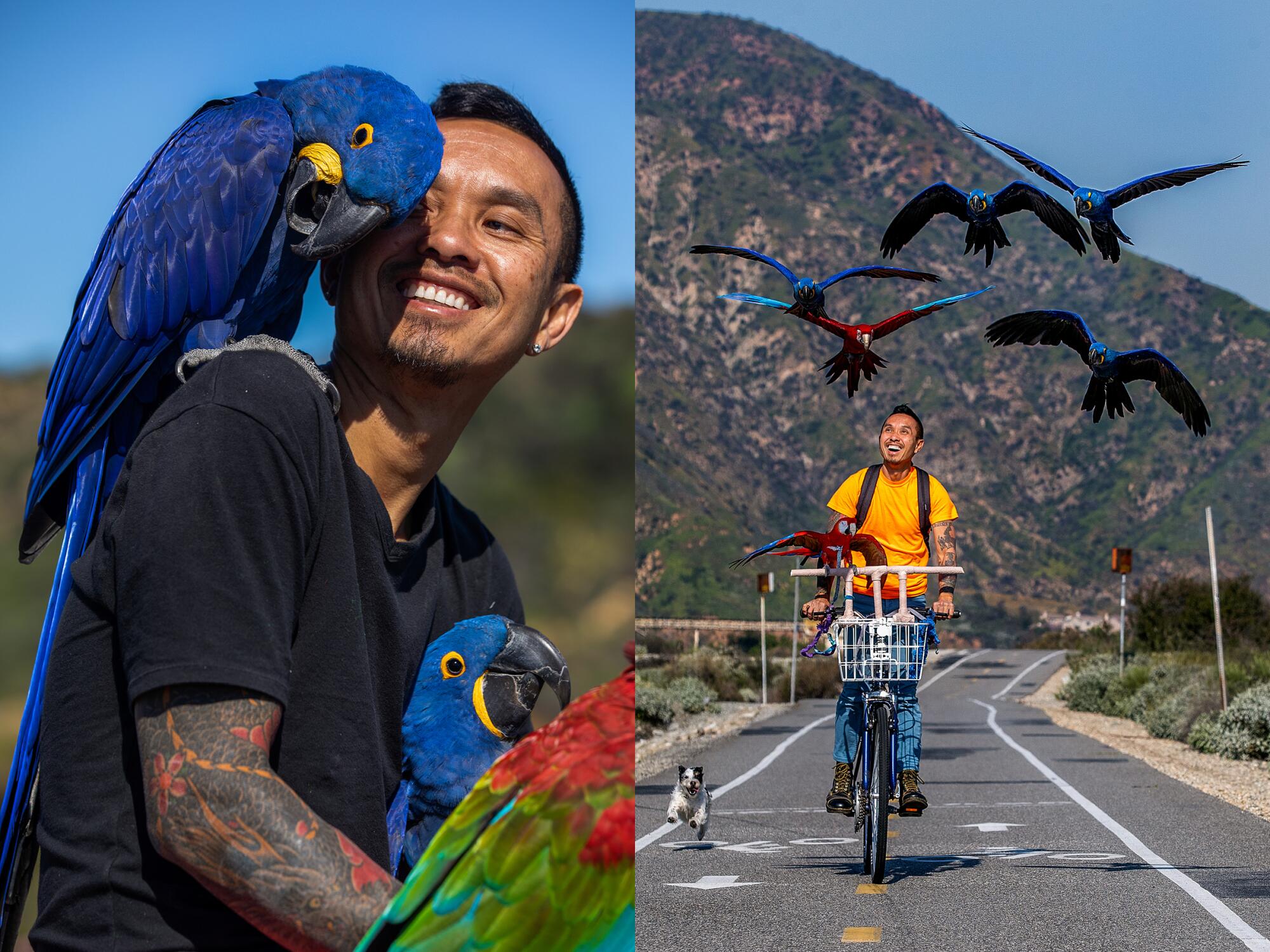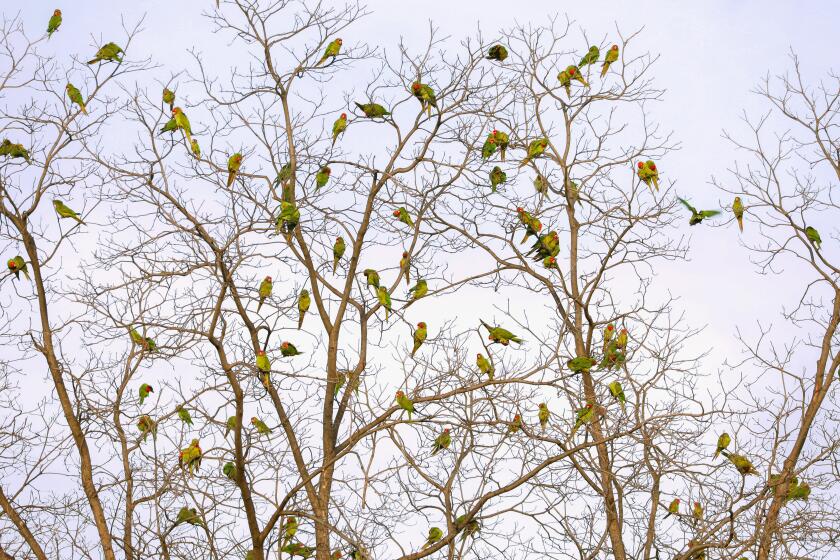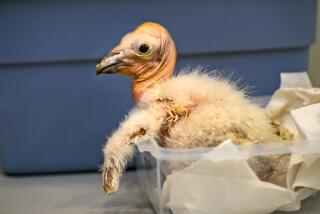
- Share via
As he flings his outstretched arms toward the sky, Chan Quach’s six royal blue and fire-engine red macaws furiously pump their wings as they take flight on one of his many popular Instagram reels. Even more impressive is when upon command, one by one, his majestic hyacinth macaws — the world’s largest parrots by length — return obediently to perch on his arms.
“There’s nothing like seeing your bird fly out of sight into the Los Angeles metropolis … but returning, screaming like a pterodactyl dinosaur — to find me,” says Quach.
If you’ve ever hiked Runyon Canyon, Griffith Park or Kenneth Hahn State Recreation Area, you may have encountered Quach, known as Chan the Birdman, and his flock — Bella, Rudy, Bruno, Roxy, Sunshine and Anya. His birds include a scarlet macaw, a green-winged macaw and four rare blue hyacinth macaws. “We travel as a flock on excursions from two to five hours daily,” he says. “We need to go together because if you isolate any of the birds, you’ve rejected a family member, and you’ll run the risk of the outcast flying off and never returning.”
When he explores L.A. with his rainbow-colored crew, Quach gets plenty of love and requests for photos but also faces pushback. Many restaurants and establishments that welcome dogs with open arms turn away Quach and his birds. He is on a mission to inspire locals and businesses to welcome his birds — just as they do dogs.

He eats, sleeps, walks, bikes and drives with his parrots
Quach is a professional bird behaviorist focused on treating and preventing problematic behaviors by pet birds. He also trains owners on how to let their birds fly outside in safe areas and return to them, a practice known as free flying.
He spent 15 years teaching math and biology at San Francisco elementary schools and applies his experience working with youths to bird training. Quach models proper behavior to his birds when they are young and invests significant time in socializing and exercising them. “Parrots are like eternal toddlers — they are smart, curious, and bore easily,” he says, “so you have to keep a close eye on them and provide them with regular stimulation.”


He’ll work out his flock for several hours daily when the weather is too cold or rainy to fly. “One exercise I’ll have them do is flying up and down in different angles like in geometry — 90 degrees, 60, 30, etc.,” says Quach. “But sometimes they’re like, ‘I’m not doing this.’ That’s where my skill set comes in; I have to motivate them just like a trainer, saying, ‘Come on, let’s go!’”
There are a couple of reasons you might be finding it harder than ever to tune out the squawks, whistles and trills of Los Angeles’ wild parrots.
His core belief is the importance of building unbreakable bonds with birds — similar to owners’ trust in their dogs and cats. Quach’s birds are allowed to sleep cageless on perches in his bedroom. “They very cautiously creep onto my body just after sunrise, and soon I’m covered in six birds,” says Quach. “If I don’t make eye contact, they pretend they’re not there, but they’re heavy — three to four pounds each. If I don’t want them to start snuggling, rolling and playing with me, I close my eyes and pretend I’m sleeping.”


“My work with birds is nontraditional, and I focus on building a strong relationship with my birds. With this foundation, your birds will want to please you. Parrots are unlike dogs — domestically bred for thousands of years to be automatically obedient to humans,” he says.
Proper bird behavior training, exercise and fraternization are vital because “an unhappy bird can experience psychosis, which can lead to aggression, mutilation, feather plucking, even eating themselves, which is very scary.”
Respect and acceptance of his birds is critical to Quach because of his experiences with discrimination. “I was a Chinese Vietnamese refugee, and my family settled in Minnesota. We looked fresh off the boat and had different faces, so we were picked on and disrespected.” While saying “I don’t see color” has become a disdained cliché, Chan likes to say, ”Growing up, I saw colors.” Although most people were kind and generous in Minnesota, he experienced culture shock and otherness. That’s why he is committed to teaching L.A. to love something unfamiliar — like a flock of free-flying parrots.
Should birds fly free?
Free flying is growing in popularity — the TikTok hashtag #freeflightbirds has more than 540 million views, with macaws as frequent stars. The practice has its critics, who argue that free flight exposes pet birds to dangers including predators, power lines and bad weather. However, Quach says his training is an extensive process that requires months of rigorous sessions. “That’s why I have a record of free flying birds for 14 years with the same flock,” he says.
Controversially, Quach free flies his macaws without using a GPS or telemetry tracker fastened to their tail feathers or wrapped around an ankle. Other owners have told Quach it’s irresponsible to fly expensive and endangered birds without using technology for the bird’s safety. “Shame on you, some say,” says Quach. “How dare you promote free flight without transmitters? I have every right to use them.”
He doesn’t judge owners who choose to use GPS trackers and smartphone apps. Quach’s technique of free flying his birds together as a flock provides safety in numbers, he says, and the birds also help call each other back when it’s time to return. For students with just one bird, he focuses on training them to work in a pair and recommends flying “with a friend who has successfully flown their bird for many years,” says Quach.


His hyacinth macaws are listed as vulnerable on a renowned risk-assessment tool for species extinction, which has led to even more criticism of his free-flying practices. However, he says, “I don’t acquire or collect birds to imprison them. I want them to live their best lives, flying safely. If I can build a true friendship, that’s greater than anything technology can offer me. Free flying has existed in Asia for thousands of years because nomadic people (such as the Kazakh people) relied on their eagles to hunt for food. They didn’t have iPhones.” Although the origins are murky, the earliest records of falconry trace back to Asia and the Middle East more than 6,000 years ago. Quach says the free-flying techniques used to free fly parrots are built upon falconry techniques.
Griffith Park urban ecologist Courtney McCammon shares information about L.A.’s raptors, which include red-tailed hawks, red-shouldered hawks, Cooper’s hawks, Western screech owls and peregrine falcons. Take a tour or get involved with the L.A. Raptor Study to learn more.
“He’s very dedicated to his birds,” says Lisa Woodworth of Eclectus Ark, a nonprofit avian resource and conservation institute. “While he does not fly them with transmitters, macaws are different from some other species of birds in that they have a very strong pair bond; they see him as the being they’re linked with, so they return to him.”

Still, others are against any ownership of rare and endangered species. Woodworth counters, “Birds that are endangered and domestically raised do not impact the species in any way except positively. Owning birds like hyacinth macaws builds awareness of their plight in the wild and creates a nongenetic pool from which to pull individuals” for repopulation programs. For example, the Assn. for the Conservation of Threatened Parrots, a German nonprofit, spearheads a multiyear project to pool Spix’s macaws from private collections to breed a diverse group that will be released in Brazil, where they have been extinct for many years.
“Without captive ownership, that can’t happen,” Woodworth says.
To preserve species like his hyacinth macaws, Quach hopes when Angelenos see his rainbow-colored birds free-flying in the sky, they’ll stop swiping on their screens and viscerally experience the wonder of nature. “The awe and emotion I feel each time, even after two decades of work in this field, still hits me every time,” he says.

- Share via
Watch L.A. Times Today at 7 p.m. on Spectrum News 1 on Channel 1 or live stream on the Spectrum News App. Palos Verdes Peninsula and Orange County viewers can watch on Cox Systems on channel 99.
More to Read
Sign up for The Wild
We’ll help you find the best places to hike, bike and run, as well as the perfect silent spots for meditation and yoga.
You may occasionally receive promotional content from the Los Angeles Times.















